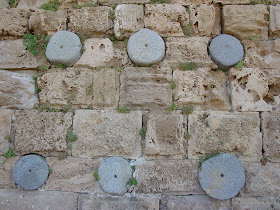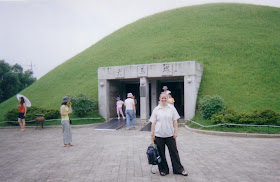Listening to 'Salt: A History' on my way to work this morning reminded me of one of the most amazing mines I've ever visited: Wieliczka in Poland, which is around 15km from Krakow and has been operating for centuries (built in 13th C) right up until 2007, when falling salt prices and mine floods made commercial mining no longer viable.
After descending 378 tiny stairs 64m deep into the ground -- it is 327m deep -- you reach a 3km series of tunnels, beautifully laid out, with intricate salt carvings, and even a cathedral (54m x 17m x 12m high), with everything, even the chandelier, being made from salt. It stretches an impressive further 287 km into various chambers and tunnels, some used by the Germans in World War II for various military industries.
 Though we didn't see the underground lake, the Chapel of the Blessed Kinga, built between 1895-1927 and showing the extraction of around 20,000 tonnes of salt, was impressive enough.
Though we didn't see the underground lake, the Chapel of the Blessed Kinga, built between 1895-1927 and showing the extraction of around 20,000 tonnes of salt, was impressive enough. Wikipedia gives a charming story of the origins of the Chapel's name: "There is a legend about Princess Kinga, associated with the Wieliczka mine. The Hungarian noble was about to be married to Bolesław V the Chaste, the Prince of Kraków. As part of her dowry, she asked her father for a lump of salt, since salt was prizeworthy in Poland. Her father King Béla took her to a salt mine in Maramureş. She threw her engagement ring from Bolesław in one of the shafts before leaving for Poland. On arriving in Kraków, she asked the miners to dig a deep pit until they come upon a rock. The people found a lump of salt in there and when split it in two, discovered the princess's ring. Kinga had thus become the patron saint of salt miners in and around the capital.[4]" Retrieved April 2013.
Wikipedia gives a charming story of the origins of the Chapel's name: "There is a legend about Princess Kinga, associated with the Wieliczka mine. The Hungarian noble was about to be married to Bolesław V the Chaste, the Prince of Kraków. As part of her dowry, she asked her father for a lump of salt, since salt was prizeworthy in Poland. Her father King Béla took her to a salt mine in Maramureş. She threw her engagement ring from Bolesław in one of the shafts before leaving for Poland. On arriving in Kraków, she asked the miners to dig a deep pit until they come upon a rock. The people found a lump of salt in there and when split it in two, discovered the princess's ring. Kinga had thus become the patron saint of salt miners in and around the capital.[4]" Retrieved April 2013.
Because of the mine's importance in Polish history (and also that of the empires that controlled it), there have been many famous visitors over the centuries, from royals to scientists (such as Copernicus), musicians (such as Chopin), popes, presidents, and more. And why not -- with its own performing band and supposedly the best acoustics of any area in Europe, it is built to impress!
 |
| 'The Last Supper' |
Update November 2013: Apparently the mine has ceased producing Salt and has been turned into a tourist resort with hotels and a theme park of sorts. You can read more about it here.
Source: Lonely Planet Eastern Europe 8th Edition http://en.wikipedia.org/wiki/Wieliczka_Salt_Mine

















































